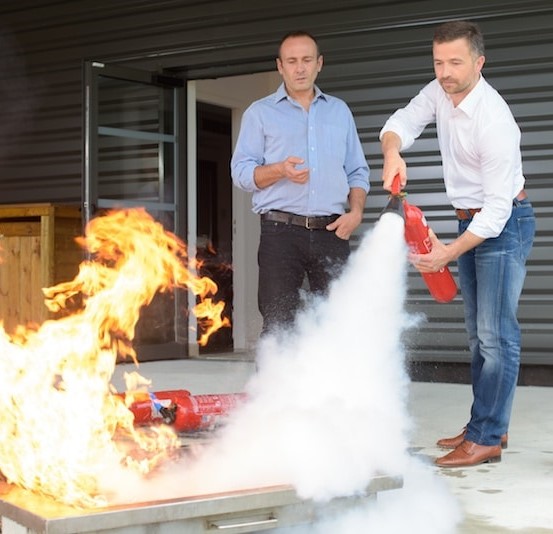How To Use a Fire Extinguisher
May 18, 2022
There are several types of fire extinguishers for different types of fire and each is applied differently. Below is a guide outlining how to use each type of extinguisher.
In all cases, only tackle a small fire with an extinguisher. If the fire has taken hold do not attempt to fight it with an extinguisher but evacuate immediately and call the emergency services. If you do tackle the fire always maintain a safe distance.
How to Use Water Fire Extinguishers
- Suitable for A Class Fires – combustible materials such as wood, paper and textiles
- Check there is no live electrical equipment in the area
- At the top of the extinguisher, pull the safety pin, breaking the tamper seal
- Squeeze the lever to start discharging the extinguisher
- Aim the extinguisher nozzle
- Fires spreading horizontally – aim the nozzle at the base of the fire, moving across the area of the fire
- Fires spreading vertically – aim the nozzle at the base of the fire, moving upwards following the direction of the fire
- As the fire starts to diminish carefully move closer to it
- Ensure all the fire has been extinguished, try to focus on any hot spots that may re-ignite
How to Use Foam Fire Extinguishers
- Suitable for A and B Class Fires – combustible materials and flammable liquids, used in different ways depending on the fire
- At the top of the extinguisher, pull the safety pin, breaking the tamper seal
- Squeeze the lever to start discharging the extinguisher
- Aim the extinguisher nozzle
- Flammable liquids – aim the hose at a vertical surface near the fire, do not spray directly at the fire as this could cause burning liquid to splash and the fire to spread to surrounding areas. Foam extinguishers build up foam on the surface of the burning liquid, cutting of oxygen supply and cooling the hot liquid
- Solid combustibles – aim the nozzle at the base of the fire, moving across the area of the fire
- Ensure all of the fire has been extinguished, the foam creates a blanket over the fire and helps prevent re-ignition
How to Use CO2 Fire Extinguishers
- Suitable for electrical and Class B liquid fires, but used in different ways depending on the fire. Do no use CO2 extinguishers in confined spaces without good ventilation, CO2 gas is poisonous and can be fatal
- At the top of the extinguisher, pull the safety pin, breaking the tamper seal
- The horn of our extinguishers are frost-free, but please be careful in using alternatives as this becomes extremely cold during use and can lead to severe frost burns
- Squeeze the lever to start discharging the extinguisher. CO2 extinguishers make a very loud discharge noise, this is normal
- Aim the extinguisher nozzle
- Flammable liquids – aim the horn at the base of the fire and move across the area being careful not the splash the burning liquid
- Electrical equipment – switch off the power where safe to do so to prevent later re-ignition, direct the horn straight at the fire
- CO2 extinguishers have a very short discharge time
- Ensure all the fire has been extinguished as re-ignition is easily possible when a CO2 extinguisher has been used. CO2 gas drifts off after use and if the fire is still very hot it may re-ignite
How to Use Powder Fire Extinguishers
- Suitable for Class A, Class B and Class C fires, but used in different ways depending on the fire
- Please be aware the powder from the extinguisher spreads and might be inhaled, it can also reduce visibility, be cautious of using in enclosed spaces
- At the top of the extinguisher, pull the safety pin, breaking the tamper seal
- Aim the extinguisher nozzle
- Solid materials – aim the nozzle at the base of the flames, moving across the are of the fire
- Spilled liquids – aim the nozzle at the near edge of the fire and with a rapid sweeping motion, drive the fire towards the far edge until all the flames have been extinguished
- Flowing liquid – direct the nozzle at he base of the flames and sweep upwards until all the flames have been extinguished
- Burning gas – switch off the gas supply as soon as you can. Aim the powder at he flare to extinguish
- Electrical equipment – Switch off the power, if safe to do so, then direct the nozzle straight at the fire
- Once the fire is extinguished, carefully scan for re-ignition, as this is possible when a powder fire extinguisher has been used
Please note that we provide easy-to-understand guidance. To make detailed decisions about your fire safety needs, you might require further advice or need to consult the full standards, legislation or your insurance. For any further assistance with product selection or advise please don’t hesitate to contact us 01493 440464/ info@uksafetyproducts.com
